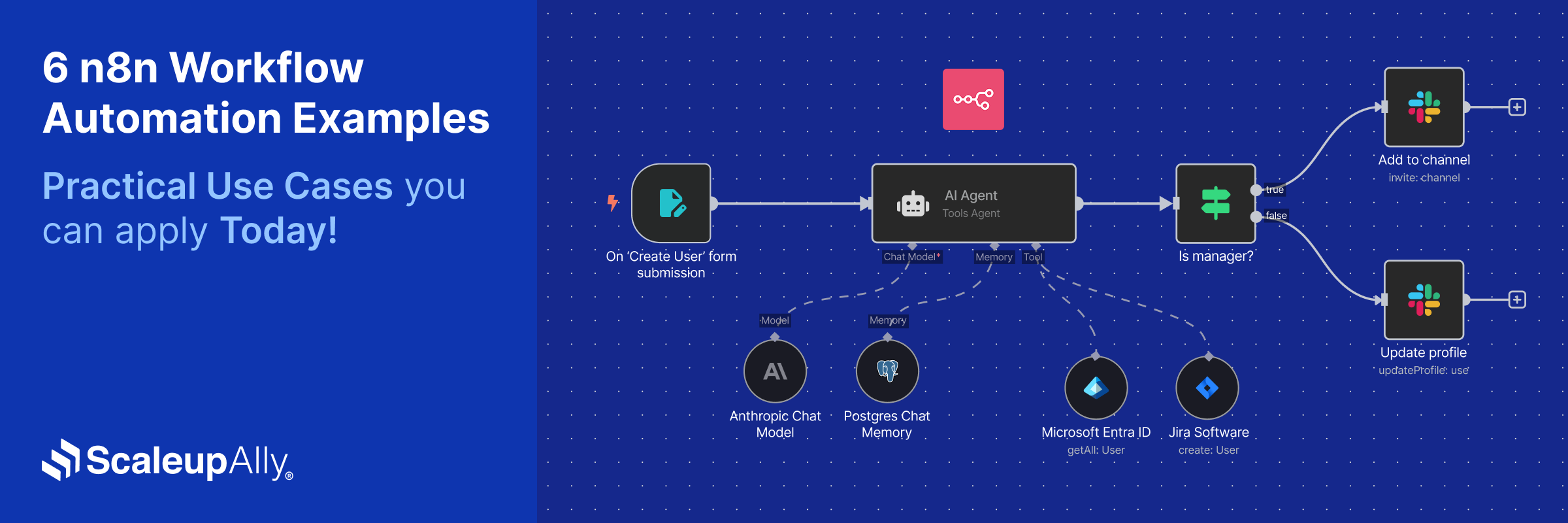
6 N8N Workflow Automation Examples: Practical Use Cases You Can Apply Today
Manu Jain | August 30, 2025 , 11 min read
Table Of Content
N8N offers a powerful, open-source platform for building custom automations without extensive coding knowledge. These six practical examples are real-world applications you can implement immediately. Each workflow addresses common business challenges. Modify these templates for your needs, and start saving hours of manual work today.
Key Takeaways
- Build failure recovery into every workflow to prevent costly crashes and data corruption
- Use batch processing, parallel execution, and data caching to handle growth without performance collapse
- Break complex automations into smaller, connected pieces that are easier to debug and maintain
- Set up health checks, logging, and graduated alerts so you know about rising issues before your customers do
- Use actual data volumes and failure scenarios in staging environments that mirror production exactly
Real-World N8N Workflow Automation Examples
These six N8N workflows solve problems that drain productivity and create bottlenecks in growing businesses. Each example includes tools and steps you can implement.
Example 1: Automated Social Media Cross-Posting
This workflow reshares your Instagram posts across Twitter, LinkedIn, Facebook and other social media platforms with formatting that supports each platform.
Use Case
Content creators and businesses waste 2-3 hours every day to post the same content across multiple platforms. This automation eliminates redundant work while maintaining a consistent brand presence. It is perfect for influencers or small businesses that manage multiple accounts.
Tools Used
- Instagram Business API
- Twitter API v2
- LinkedIn Pages API
- Facebook Graph API
- N8N HTTP Request nodes
- N8N Schedule Trigger
Step-by-Step Process
- Set up a Schedule Trigger to run every hour during business hours
- Configure an Instagram Business API node to fetch your latest posts
- Add an IF node to check for new posts since the last run
- Create separate branches for each platform using HTTP Request nodes
- Format content for X (character limits), LinkedIn (professional tone), Facebook (engagement focus)
- Include image processing nodes to resize media for platform requirements
- Set up error handling with email notifications for failed posts
- Add a final node to log successful cross-posts to a Google Sheet for tracking
Example 2: E-commerce Order Processing and Customer Communication
This workflow handles inventory updates and generates invoices.
Use Case
Online store owners manually handle order processing and inventory management. This automation reduces order processing time from 15 minutes to 30 seconds while eliminating human error in inventory tracking and customer updates.
Tools Used
- Shopify/WooCommerce Webhook
- Gmail SMTP
- Google Sheets API
- Slack API
- PDF generation service
- Shipping carrier APIs (FedEx/UPS)
Step-by-Step Process
- Configure a webhook trigger for new orders from your e-commerce platform
- Extract order details and customer information using data transformation nodes
- Update inventory levels in Google Sheets using spreadsheet formulas
- Generate a PDF invoice with customer details and an itemized breakdown
- Send order confirmation email with invoice attachment to the customer
- Post order summary to the team’s Slack channel for fulfillment tracking
- Create shipping label through carrier API integration
- Schedule follow-up email sequence: shipping confirmation, delivery notification, review request
- Update order status back to e-commerce platform
- Log transaction details to accounting software for bookkeeping
Example 3: Lead Qualification and CRM Integration
Automatically score, qualify, and route leads from multiple sources into your CRM with personalized follow-up sequences. This workflow eliminates manual lead processing and ensures no potential customer falls through the cracks.
Use Case
Responding within an hour makes you nearly 7× more likely to qualify the lead than if you respond later. This automation instantly qualifies leads, assigns scores, and triggers appropriate follow-up actions based on lead quality and source.
Tools Used
- HubSpot/Salesforce CRM API
- Typeform/Gravity Forms webhook
- Clearbit Enrichment API
- Mailchimp/ActiveCampaign
- Slack notifications
- Google Sheets for lead scoring matrix
Step-by-Step Process
- Set up form submission triggers from website contact forms and landing pages
- Enrich lead data using the Clearbit API for company information and social profiles
- Calculate lead score based on job title, company size, budget, and urgency indicators
- Route high-quality leads (score >75) directly to the sales rep via Slack notification
- Add medium-quality leads (score 40-75) to the nurture email sequence in Mailchimp
- Archive low-quality leads (score <40) with a thank you email
- Create or update a contact record in CRM with enriched data
- Schedule follow-up tasks for the sales team based on lead score and source
- Send the internal lead report to the sales manager with a daily lead summary
- Track conversion rates by lead source in the Google Sheets dashboard
Example 4: Content Backup and Version Control System
Protect your digital assets by automatically backing up social media content and marketing materials across multiple cloud storage platforms with version tracking.
Use Case
Content creators lose hours of work when platforms crash or accounts get suspended. This workflow creates redundant backups of all content with timestamps and version history, ensuring business continuity during platform disruptions.
Tools Used
- WordPress REST API
- Google Drive API
- Dropbox API
- AWS S3 storage
- GitHub API (for version control)
- N8N Cron node for scheduling
Step-by-Step Process
- Schedule a daily backup routine using a Cron trigger at 2 AM
- Fetch all published content from WordPress using REST API endpoints
- Compare the current content with the previous backup using hash comparison
- Process only modified or new content to minimise storage usage
- Save content to Google Drive in an organized folder structure by date
- Create a secondary backup in Dropbox with the same organizational system
- Upload critical content to AWS S3 for long-term archival storage
- Commit content changes to the GitHub repository for version tracking
- Generate a backup report with file counts and storage usage statistics
- Email backup summary to the admin team with any errors or warnings
Example 5: Customer Support Ticket Routing and Response Automation
Intelligently categorise support tickets, route them to appropriate team members, and provide instant acknowledgements with estimated resolution times based on ticket complexity.
Use Case
Support teams struggle with ticket backlogs and inconsistent response times. This automation reduces initial response time to under 2 minutes while ensuring tickets reach the right specialist immediately, in order to improve customer satisfaction.
Tools Used
- Zendesk/Freshdesk API
- OpenAI GPT API for classification
- Slack team notifications
- Google Calendar for availability checking
- Twilio SMS for urgent issues
- Jira for bug tracking integration
Step-by-Step Process
- Configure webhook trigger for new support ticket submissions
- Analyze ticket content using OpenAI API to determine category and urgency level
- Check team member availability using Google Calendar integration
- Route tickets to appropriate specialist based on category and workload
- Send immediate acknowledgment email to customer with ticket number and timeline
- Create Slack notification in relevant team channel with ticket summary
- For urgent issues, send SMS alert to on-call team member
- If bug-related, automatically create Jira ticket with technical details
- Set up follow-up reminders based on SLA requirements for each priority level
- Update customer via email when ticket status changes or resolution is provided
Example 6: Financial Data Aggregation and Reporting Dashboard
Consolidate financial data from multiple sources into comprehensive reports with automated calculations and trend analysis.
Use Case
Finance teams spend 8-12 hours monthly compiling reports from various platforms. This automation reduces reporting time to 30 minutes while providing real-time insights and eliminating manual calculation errors that cost businesses thousands in bad decisions.
Tools Used
- QuickBooks/Xero API
- Stripe payment processing API
- PayPal Business API
- Google Sheets for calculations
- Gmail for report distribution
- Chart.js for visualization
- PDF generation service
Step-by-Step Process
- Schedule monthly trigger on the first day of each month
- Fetch transaction data from QuickBooks covering the previous month
- Pull payment processor data from Stripe and PayPal APIs
- Reconcile transactions between accounting software and payment processors
- Calculate key metrics: revenue growth, expense ratios, profit margins, cash flow
- Generate trend analysis comparing current month to previous 3 months
- Create visual charts showing revenue by source, top expenses, and growth patterns
- Compile comprehensive PDF report with executive summary and detailed breakdowns
- Email personalized reports to different stakeholders (CFO gets full report, managers get department summaries)
- Archive report data in Google Sheets for historical analysis and audit trails
Challenges in Building N8N Workflows
While N8N promotes itself as a simple drag-and-drop automation tool, building truly effective workflows is rarely that straightforward. Developers often encounter unexpected technical challenges. Here are some:
1. API Rate Limits and Quota Management
Many third-party services enforce strict API quotas, which may interrupt your workflows. For example, Instagram allows just 200 API calls per hour, while Salesforce caps basic plans at 1,000 requests per day. Even a well-designed workflow can fail if it unknowingly runs into these hidden ceilings during peak activity.
As a solution, use exponential backoff strategies and spread requests across multiple time windows. N8N’s Wait nodes can help create queue systems that automatically pace requests and prevent rate-limit errors.
2. Error Handling Complexity
N8N workflows fail when exceptions occur. A single API timeout can crash an entire sequence, leaving partial data updates that corrupt your systems. Traditional programming languages offer robust error handling, but visual workflow builders struggle with complex exception management.
Building reliable error recovery means planning for every failure point (network timeouts, invalid data formats, missing fields, service outages, and even sudden permission changes).
3. Scalability Bottlenecks
N8N workflows that handle a few hundred records may run without issue, but the same workflows often collapse under enterprise-level loads. Large datasets trigger runaway memory consumption, and execution times grow exponentially rather than linearly. Since N8N lacks native horizontal scaling, workflows can quickly hit system limits.
Best Practices for Creating Efficient Workflows
Successful n8n automation examples share common patterns. These practices prevent the costly mistakes that most workflow projects face.
1. Implement Intelligent Data Validation
Validate incoming data at workflow entry points using strict schemas. Reject malformed inputs immediately rather than processing garbage that corrupts downstream systems. Email addresses must contain @ symbols, phone numbers should match regional patterns, and dates require standard formatting.
2. Optimize for Performance and Scale
Process data in batches rather than individual records. Updating 1,000 customer records through single API calls takes hours, while batch operations complete in minutes. Most modern APIs support bulk operations that dramatically improve throughput.
Use parallel processing branches for independent operations. When updating CRM records and sending email notifications, run both processes simultaneously instead of sequentially.
3. Implement Robust Security Practices
Never hardcode credentials or API keys within workflow nodes. Use N8N’s credential system or external secret management services like AWS Secrets Manager. Hardcoded secrets create security vulnerabilities and complicate credential rotation procedures.
Implement least-privilege access patterns for all service integrations. API keys should only grant permissions necessary for specific workflow functions. Overprivileged credentials increase blast radius during security incidents.
Conclusion
These N8N workflow automation examples prove that smart automation transforms businesses overnight. The difference between success and failure lies in following proven practices while avoiding common pitfalls. Your competition is already automating – every day you wait costs money and opportunities.
Ready to build workflows that actually work? Contact us for expert implementation guidance.
Frequently Asked Questions
Q. What can you automate with n8n?
N8N automates virtually any repetitive digital task that involves moving data between systems. Popular automation targets include social media management, customer support workflows, e-commerce order processing, lead qualification pipelines, financial reporting, content backup systems, and marketing campaign triggers.
Q. Can non-developers use n8n effectively?
Non-developers can build simple workflows using N8N’s visual interface, but complex automation requires technical knowledge. Basic tasks like connecting Google Sheets to email notifications work well for business users. However, advanced features like error handling, data transformation, API authentication, and performance optimization demand programming experience.
Q. How do I get started with n8n workflows?
Start with N8N’s cloud version for immediate access without server setup complexity. Begin by automating one simple, high-impact process rather than attempting comprehensive business transformation. Choose a workflow that involves familiar tools like Gmail, Google Sheets, or Slack. Follow N8N’s official tutorials to understand basic concepts like triggers, nodes, and data flow. Join the N8N community forum for troubleshooting support and workflow inspiration.
Related Blogs

OpenAI for Businesses [Benefits, Use Cases & Challenges]
Discover the benefits of OpenAI for businesses. From reducing costs to scaling operations and enriching customer experiences. Real-world use cases included.
ScaleupAlly Team
Dec 16 ,
11 min read

Best 11 Agentic AI Tools in UAE: Accelerating Digital Transformation
Discover the top 11 agentic AI tools in UAE for 2025. Explore features, benefits, and tips to choose the right AI tool for your business growth.
Manu Jain
Nov 6 ,
9 min read

How to Choose an AI Development Company in Dubai: A Complete Guide
Find out how to choose the right AI development company in Dubai. Learn key factors, local considerations, and tips to select the best partner.
Manu Jain
Nov 6 ,
9 min read


